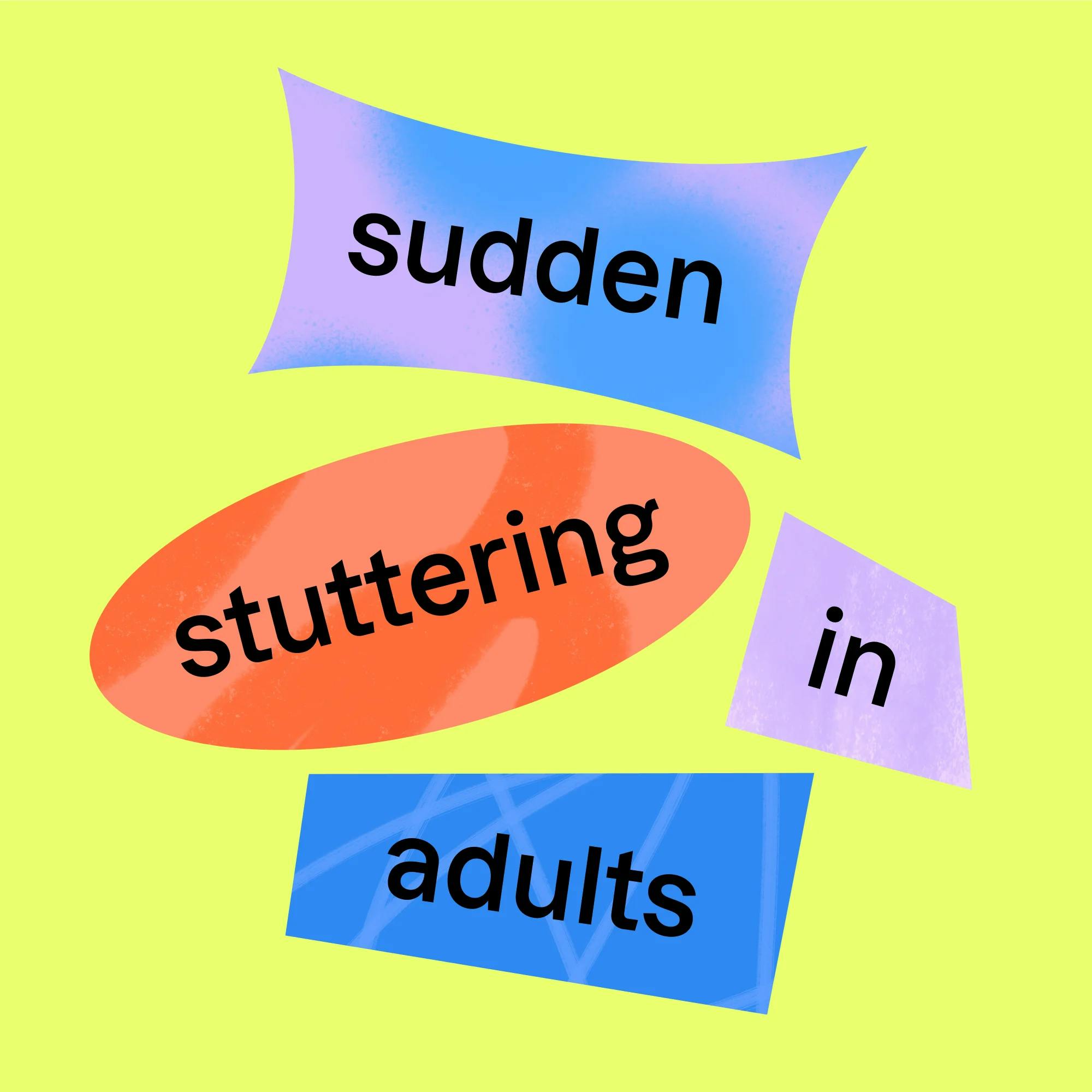Have you ever spoken with someone who stutters? It might be a family member, a coworker, or someone you’re just meeting for the first time. While it might feel different at first, the way you talk and interact with a person who stutters shouldn’t be any different than speaking with anyone else.
That said, there are things you can do to make it easier for the person to express themselves–and to feel heard and valued. In this article, our speech therapists share expert tips for how to talk with someone who stutters. Learn what stuttering looks like in conversation, some common myths about stuttering, and how to best support someone who stutters.


The do’s and don’ts of talking with someone who stutters
Stuttering is a form of verbal diversity. That means it’s a different way of speaking. When you’re talking with a person who stutters, it can feel natural to want to help them in some way. But the best thing you can do is to not help or intervene at all.
Even if a person stutters on a sound, or seems blocked and can’t get a word out, it’s still their way of speaking. If you try to control how quickly or smoothly the person speaks, this can feel frustrating to them.
Think about what you’d want if the roles were reversed. What would you like the other person to do, or not do? Here are 5 guidelines to follow when talking with someone who stutters.
1 Don’t try to talk for them
Even if the person isn’t speaking fluently (smoothly), they know exactly what they want to say. Don’t try to help them.
As Expressable speech therapist Emily Michel, M.S., CCC-SLP, explains, “Finishing someone’s sentence when they stutter might seem helpful, but it takes away their voice, adds pressure, and can leave them feeling rushed or misunderstood.”
2 Don’t appear impatient or act like they should hurry
It’s not a good feeling when you sense that someone doesn’t have time to talk with you. Even if you feel impatient, be mindful of your body language. Remain calm and relaxed, just as you would when speaking with anyone.
Finishing someone’s sentence when they stutter might seem helpful, but it takes away their voice, adds pressure, and can leave them feeling misunderstood.
3 Don’t tell them to slow down
It’s common to think that if the person just slows down, they can speak more fluently. This isn’t always true, and it’s often not helpful advice. Saying it may come across negatively.
4 Don’t ask too many questions
When talking with someone who stutters, don’t ask them too many questions, especially back to back. If the person isn’t answering the first question with smooth speech, don’t jump to another question. Give them time to answer first.
5 Use positive, friendly body language
Try not to fidget or appear distracted. Don’t look at your phone if the person is having difficulty speaking. Try to project the message that “I’m here, and I’m enjoying talking with you.”
Ada's story
After sudden stuttering took over Ada's speech, online speech therapy helped her regain her confidence and say what she wanted to say.
 Read Ada's story
Read Ada's storyWhat does stuttering look like in conversation?
There are several types of stuttering. Because of that, stuttering may look different in different people. Let’s review what a stutter might look and sound like in conversation.
Stuttering repetitions
The first type of stuttering is called repetitions. Repetitions are when a person repeats the first sound or syllable of a word at least three times more than is needed. It may sound like this: “I w-w-w-would like a glass of water” or “Put, put, put, put this here.”
Stuttering prolongations
A second type of stuttering is called a prolongation. Prolongations are when a person holds out a sound for too long, to where the speech sounds abnormal. It may sound like: “Ssssssssee the airplane?” or “Wwwwwwhere are you?”
Stuttering blocks
The third type of stuttering is called a block. Blocks are when a person is unable to move their mouth and use their voice to continue speaking. No voice or sound comes out during a block. Here’s an example of a block: “I am…………………..going to that meeting.”
You can hear what the types of stuttering sound like in this video.

Secondary stuttering behaviors
Some people who stutter also have secondary stuttering behaviors. These are physical behaviors related to a stutter. Examples of secondary stuttering behaviors include:
Body movements, such as eye blinking, jaw jerking, or fist clenching
Looking away from the listener
Tensing the muscles used for speech
Changes in voice pitch or loudness
Support for people who stutter
Speech therapy can build your confidence and help you speak more freely. Find the right speech therapist for the support you need.
 Get started
Get startedCommon myths about stuttering
There are many misconceptions when it comes to understanding stuttering. Here are some common myths–and the facts:
Stuttering is caused by being nervous. Someone who already stutters could stutter more when they’re anxious. But this is not the cause of stuttering itself. Many people who stutter don’t get nervous at all.
Someone who stutters has low intelligence. This is completely untrue. Stuttering is not connected to intelligence.
People who stutter are shy. If someone feels negative about their stuttering, they may be less likely to speak up. But this doesn’t mean they have a shy personality. Many people who stutter are not shy around others or hesitant to speak at all.


3 ways to support someone who stutters
We’ve shared tips about how to talk with someone who stutters, but there are other ways you can support them as well. Whether it’s a family member, friend, or coworker, your support can make a big difference.
1 Be inclusive
Treat the person just as you would anyone else, or just as you would if they didn’t stutter. If your child stutters, you may need to advocate for them and educate other people about their stutter. Do whatever you can to make the person feel comfortable and included.
2 Understand that the goal isn’t to “fix” a stutter
A person is more than their stutter! They are an entire human being, with likes and dislikes, a unique personality, and their own dreams and goals. Remember that stuttering is simply a different way of speaking.
Heather Gross, M.S., CCC-SLP, another Expressable speech therapist, explains it this way: “It's important to treat people who stutter with the same respect and compassion you would show anyone. Practice active listening, give them the time they need to respond, and avoid interrupting or speaking on their behalf.”
Focus on what the speaker is saying, not how they’re saying it.
Try not to hyperfocus on the person’s speech or pressure them to speak a certain way. The goal for any person is to feel empowered to speak freely and with confidence, in whatever form that takes.
3 Don’t speak negatively about the stutter
The way you talk about stuttering, especially your child’s stuttering, is incredibly important. Avoid using words like “bad,” “fix,” or “cure.”
As Heather explains, “Stuttering is a diverse way of speaking. It's not something to be fixed, or something that’s wrong. Try to not act surprised or overly sympathetic. Focus on what the speaker is saying, not how they’re saying it.”

Speech therapy offers support for stuttering
If you’re looking for speech therapy for stuttering, contact us here at Expressable. We have a dedicated team of speech therapists who are experts in working with children and adults who stutter. Our goal is to help people become as fluent, confident, and empowered as possible in their communication skills.
At Expressable, therapy is less focused on the idea of ‘perfect speech’ and more about gaining control and confidence to speak your thoughts in any situation.
Expressable speech therapist Jourdan Walker, M.S.,CCC-SLP, explains stuttering therapy this way: “Allowing treatment to be led by the person’s goals, their thoughts and experiences with fluency, and what’s working for them at this time in their life gives us the best insight into therapy that is effective and functional.
“Often we create a set of personalized tools to allow a client to confidently communicate in the way that feels most authentic to them, whether that includes some disfluencies or not. Our goals are less focused on the idea of ‘perfect speech’ and more about gaining control and confidence to speak your thoughts in any situation.”
Click here to get matched with a speech therapist who specializes in stuttering. You can also learn more about how we support children and adults who stutter in our treatment guide.
How Expressable Can Help
Concerned your child isn't reaching age-expected milestones? Looking for communication support from a professional? Expressable is a national online speech therapy practice serving children and adults. We treat all major areas of communication and feeding, offer flexible hours including evenings and weekends, and accept most major health insurance plans. We’re proud to have earned more than 3,000 5-star reviews from our clients (4.9/5 average).
Our therapy model is centered on parent and caregiver involvement. Research proves that empowering caregivers to participate in their loved one’s therapy leads to better outcomes. That’s why we combine live, 1-on-1 speech therapy with personalized education and home practice activities for faster progress.
Communication is more than words. It’s how we share how we feel and show who we are. We’re here to help you or your child do just that.

 Abby Barnes, M.S., CCC-SLP
Abby Barnes, M.S., CCC-SLP










